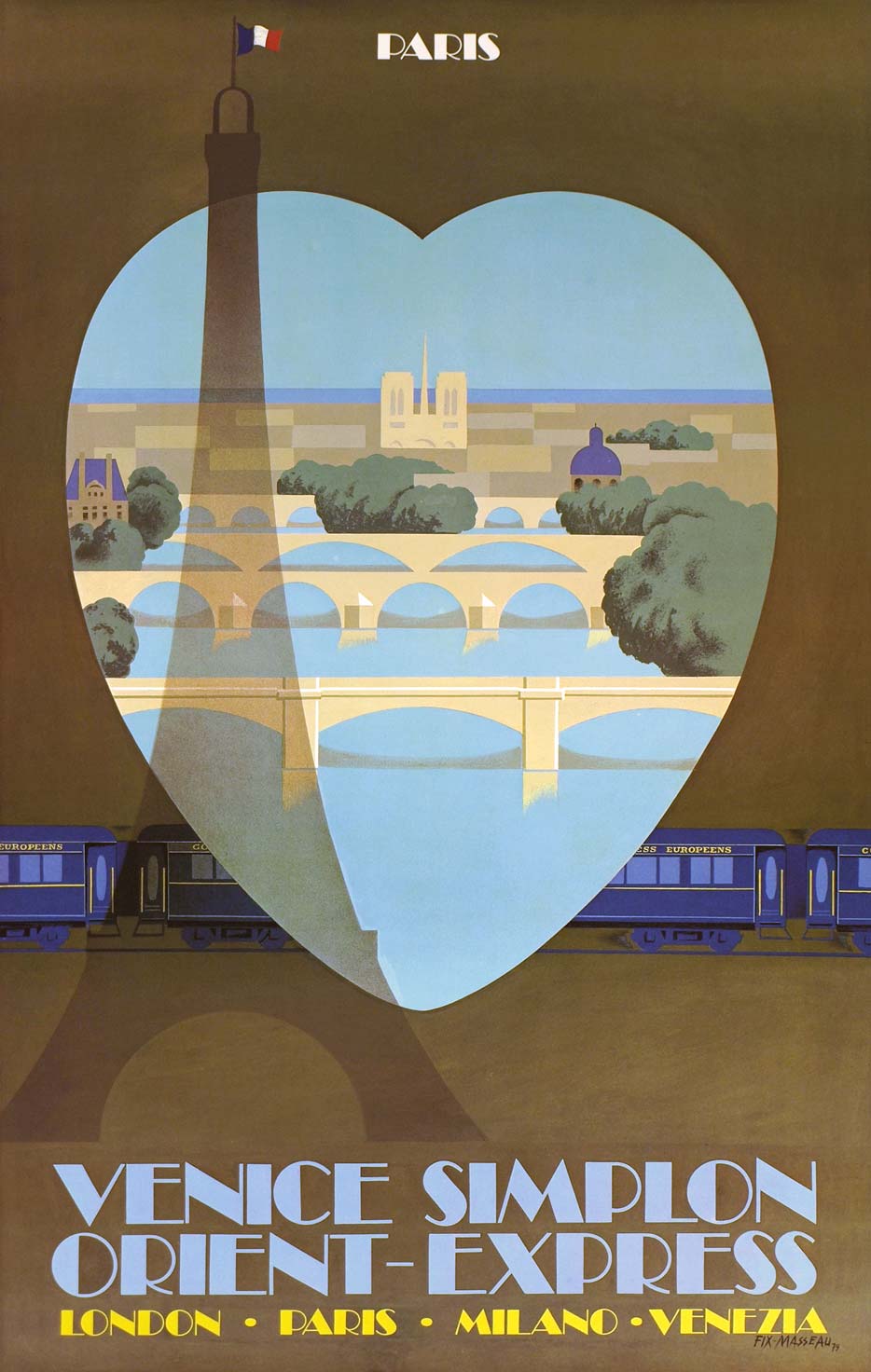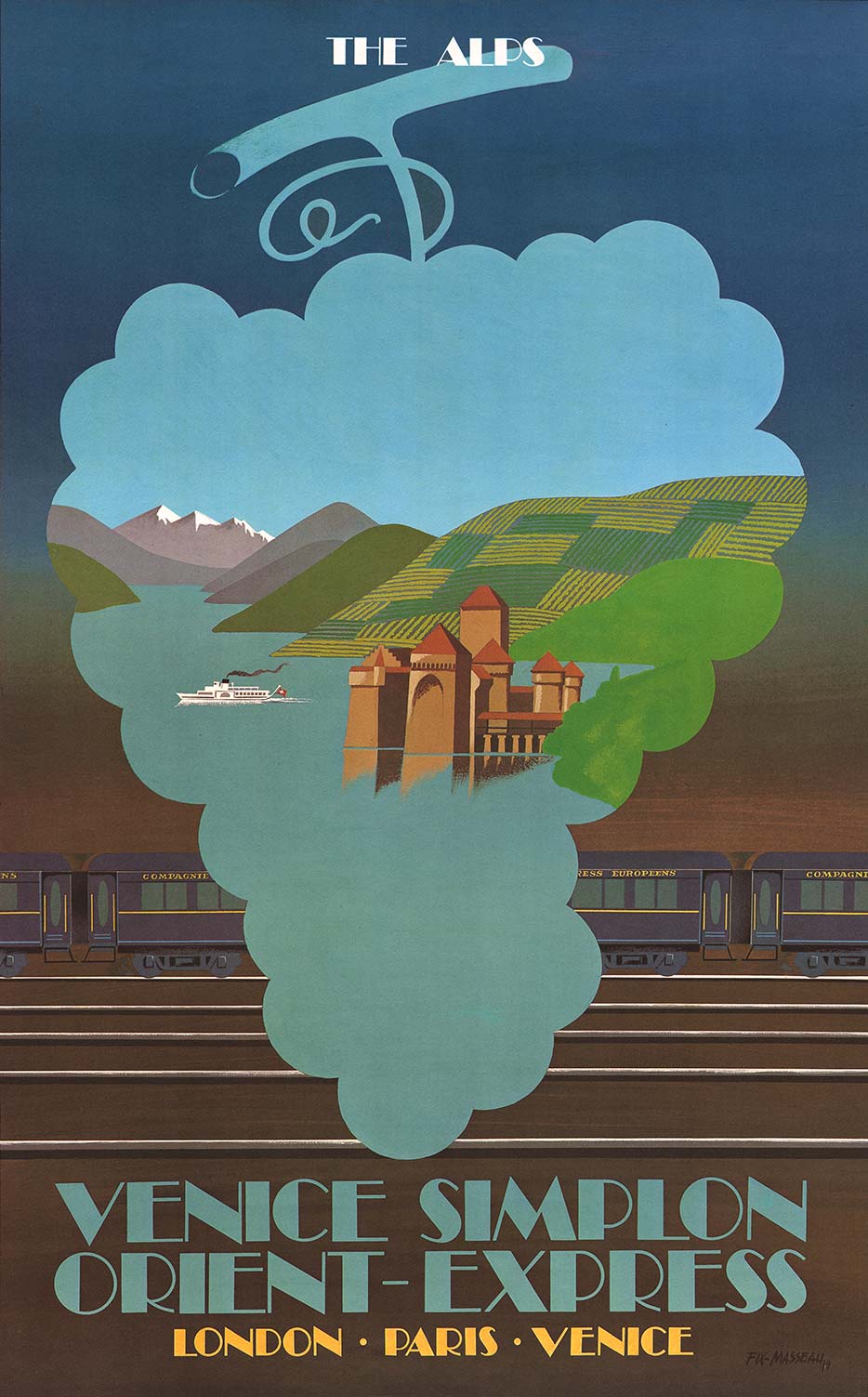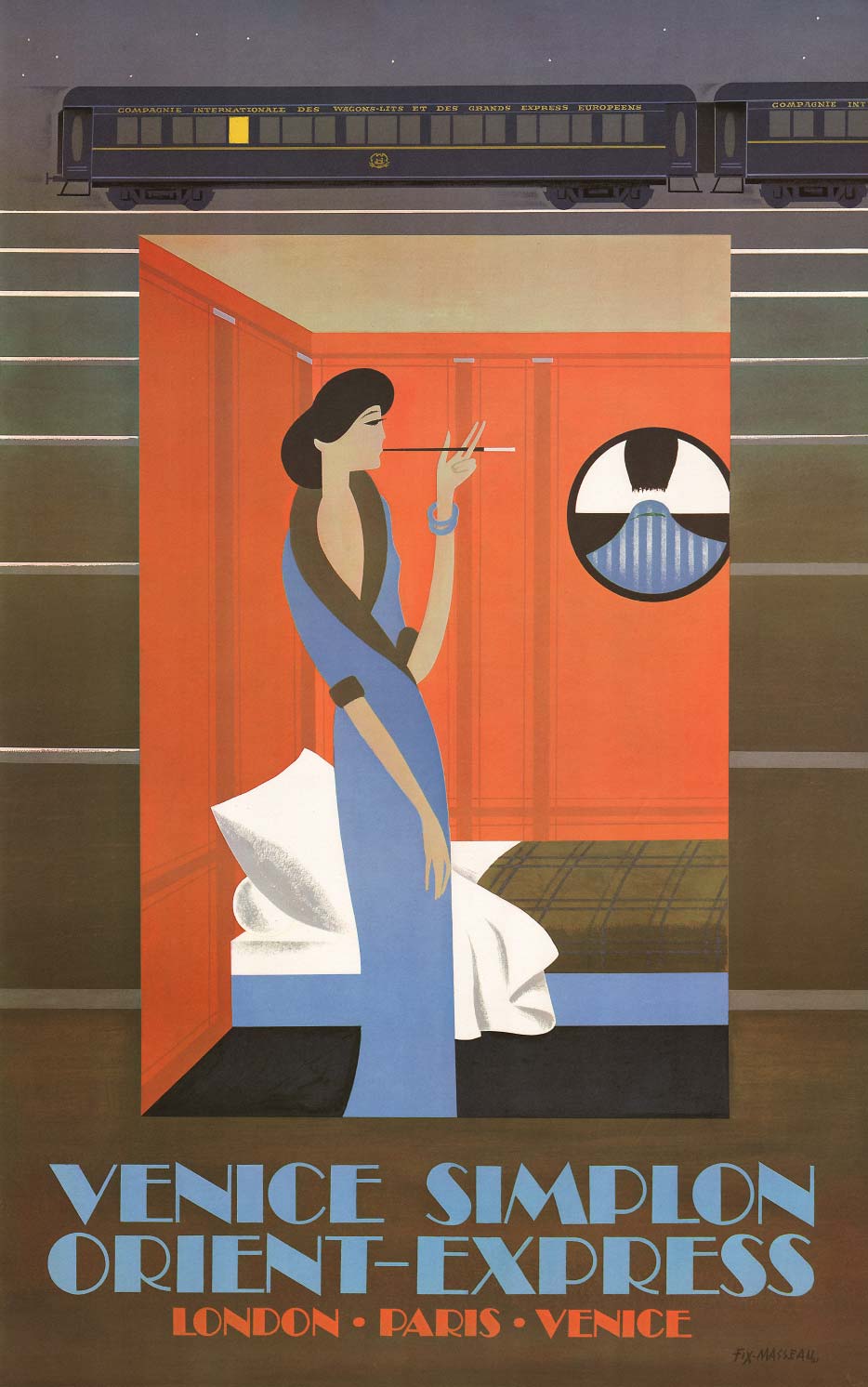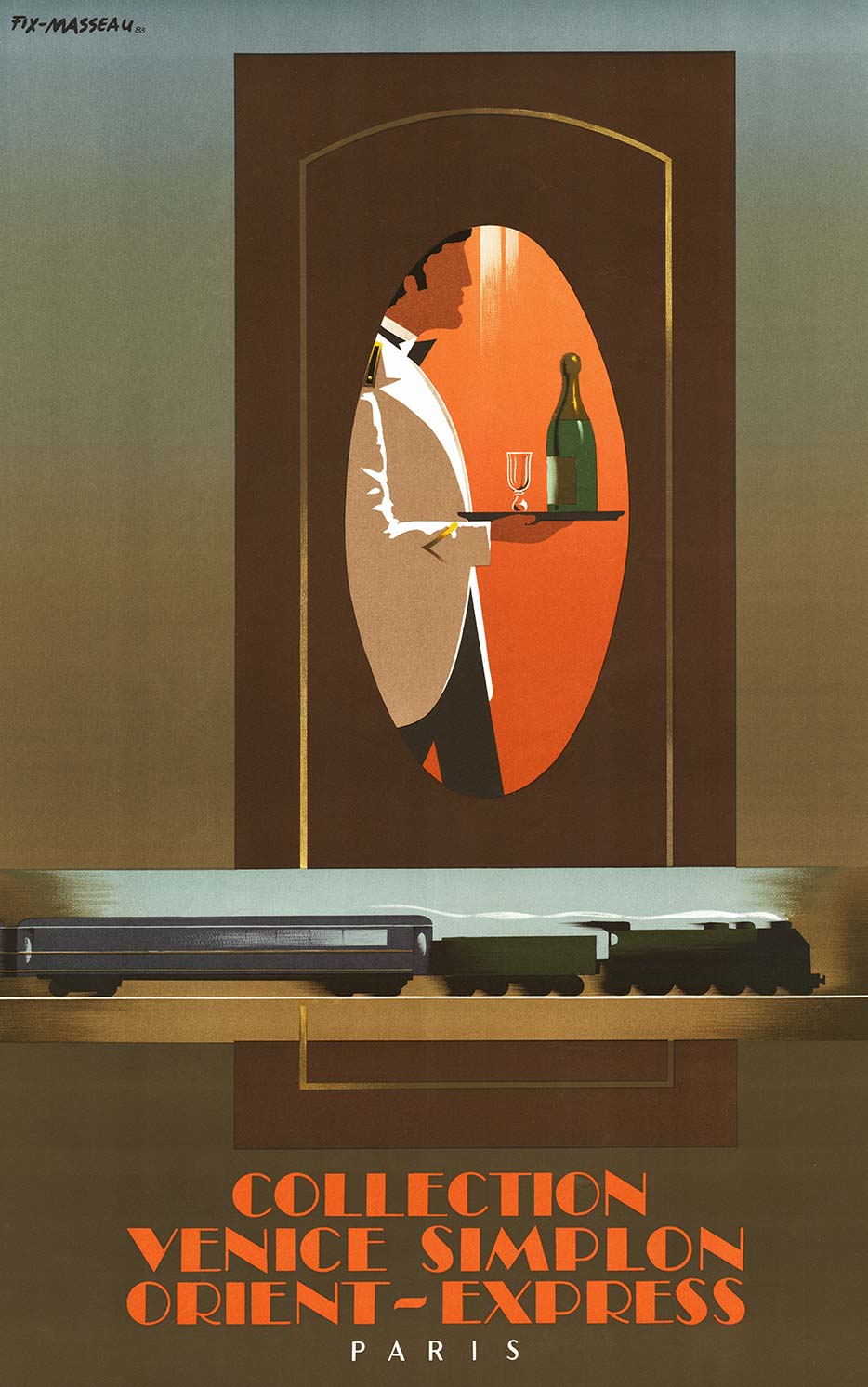Art Deco from the 1930s and 1980s
Railway posters by Pierre Fix-Masseau
 Nederlandse versie
Nederlandse versie
The French designer Pierre Fix-Masseau was one of the creators of iconic railway posters of the Art Deco period. Like his mentor, the even more renowned designer A.M. Cassandre, Fix-Masseau specialized in depicting speed and progress on posters for trains, ships and cars.
50 years after the initial succes of his famous 'Exactitude' poster, Fix-Masseau's work witnessed a second blooming together with the revival of a legendary train. His retro posters referred to the 1930s, but fonts, colors and hairstyles reveal that they date from the 1980s.
Côte d'Azur Pullman-Express
Pierre Fix-Masseau (1905-1994) was a son of French sculptor Pierre Felix Fix-Masseau. He studied at the École Nationale Supérieure des Arts Décoratifs in Paris. While working for a luxury perfume label printer, Fix-Masseau published an ad in Nord Magazine. It was noted by Cassandre, who had created the cover of the magazine. Cassandre invited Fix-Masseau to work in his studio at Versailles as an intern and assistent. During this short period in 1928 he learned 'the rigor, the graphic precision and the composition needed for a poster', as he described the experience later.
Afterwards Fix-Masseau joined the Edita publicity company where he designed packaging, advertisements and posters. Like many Art Deco designers he had a fascination for speed and new technology, visible on his posters for car manufacturers and shipping and railway companies.

The influence of Cassandre was very clear in Fix-Masseau's first railway poster, created in 1929 for the Côte d'Azur Pullman-Express. It featured diagonal lines and blur to suggest speed. The Côte d'Azur Pullman-Express was a luxury day train between Paris and Ventimiglia. It was operated by the Wagons-Lits company and PLM, which were both listed on the edges of the poster
Exactitude
Fix-Masseau's most successful poster was 'Exactitude' (precision), created in 1932 for 'Etat' (Chemins de fer de l'État, the French state railways). It shows a train at a buffer stop, the driver hanging out of the enormous steam locomotive. A station clock in the background suggests that the train has arrived exactly on time. The meticulous depiction of the whole scene also adds to the theme of precision.
The term 'Exactitude', set on the poster in very modern light lettering, was a part of a three-word slogan, widely used by 'Etat' in the 1930s: 'Exactitude Vitesse Confort' (Precision, Speed, Comfort). Other railway companies were using variations of the same catchphrase. On a poster by Cassandre, the French 'Nord' railways adopted 'Vitesse Luxe Confort' (Speed, Luxury, Comfort), while the German railways used 'Safety Speed Comfort' on English-language posters and the Dutch railways advertised with 'Veilig Vlug Voordelig' (Safe, Quick, Economical).
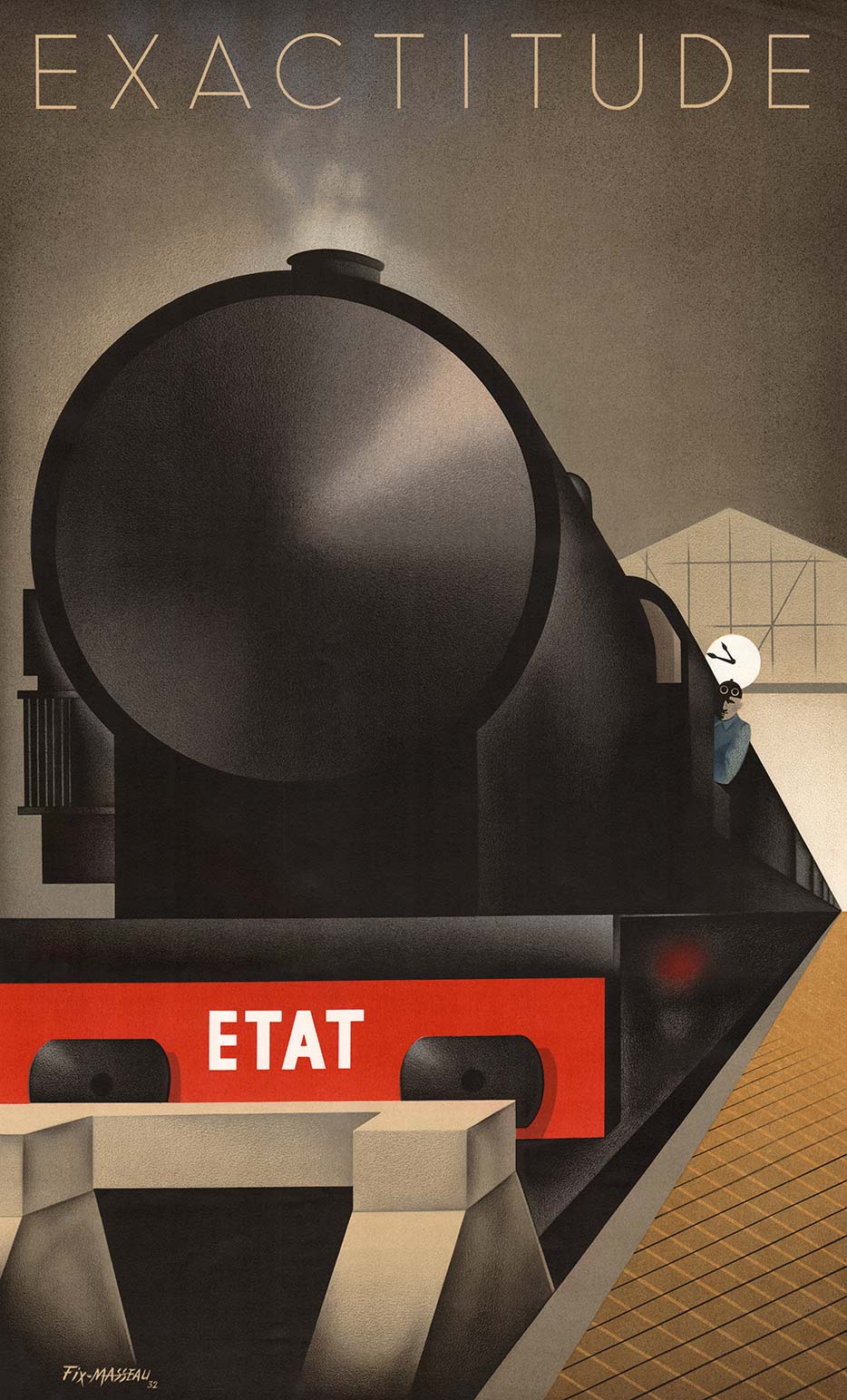
Like the slogan, the 'Exactitude' poster was part of a three-part series. A poster titled 'Confort' - in the same light letters - was designed by André Nivault in 1933, showing a sleeping car in the dark. Finally, a 'Vitesse' poster was issued the next year, although with slightly different lettering. It featured Etat's Autorail Bugatti, which broke speed records.
Once he had recognized the task of the poster, Fix-Masseau made the best possible use of such knowledge. His designs reveal at once the purpose for which they are intended and also the aims of those who are making the appeal with his posters. There is nothing vague about them on this point, nothing to blur their significance. The symbolical in these posters thus becomes a speaking, all-revealing picture.
The posters compel the genuine admiration of those who view them, quite apart from experts who have more understanding for the difficulties that confront poster-artists, and the reason for this lies in Fix-Masseau's qualities as an artist, and of which he makes masterly use. What is arresting in Masseau's work and produces the most powerful effect is his boldness in attempting the monumental. The harmonious blending of text and picture is truly astonishing.
Venice-Simplon Orient Express
In 1977 the last direct train left Paris for Istanbul, once the route of the Orient Express. Publicity about the end of this legendary train resulted in a revival. American-British entrepreneur James Sherwood bought pre-war luxury carriages and had them restored for his Venice-Simplon Orient Express (VSOE): an expensive 'rail cruise' between London, Paris and Venice. The VSOE started operating in 1982 and is still popular for honeymoons and anniversary trips. In the UK, British Pullman coaches are used, on the continent former Wagons-Lits sleeping cars and Pullman coaches. Service and food aboard are of star quality.
As the train had become retro, so did the posters. The VSOE engaged 75-year-old Pierre Fix-Masseau, who was still active as a designer after more than 50 years. He created two series of VSOE posters, printed in traditional lithographic technique on art paper as well as less expensive editions in four-color offset printing. The first series depicted the countries traversed and cities on the route: London (Victoria Station), Paris, the Alps, Milan and Venice.
Once the train service actually started, the posters featuring Lake Geneva and Milan showed a paper reality only. Despite its name and the original idea, the VSOE did not use the original Simplon line. For practical reasons it ran via Zurich and traversed Austria on its way to Venice.
The involvement of Fix-Masseau in the creation of VSOE posters was mainly thanks to James Sherwood's wife, Shirley Sherwood. She also conducted historical research for the restoration and refurbishment of the carriages and wrote a book about the process.
The involvement of Fix-Masseau in the creation of VSOE posters was mainly thanks to James Sherwood's wife, Shirley Sherwood. She also conducted historical research for the restoration and refurbishment of the carriages and wrote a book about the process.
One of the great pleasures I have had during the VSOE project has been learning to appreciate the range of railway posters. The early ones are very delightful, but the ones which have the most impact for me are those of the 1920s and 1930s and two of the most outstanding poster artists of that period were Cassandre and Fix-Masseau. It was decided that the VSOE must have some very special posters designed and [art publisher] Paul Bianchini introduced us to Pierre Fix-Masseau.
We visited him in his studio in Paris, where he showed us examples of his work including his two most famous railway posters, one for the Cote d'Azur Pullman designed in 1929 and the other called 'Exactitude', designed in 1932. Reproductions of 'Exactitude' must be in every poster shop in the world and shown to every art student as an example of superb design. Fix-Masseau was intrigued by the proposition and enthusiastically accepted a commission to do a series of posters for the train.
VSOE interior posters
Pierre Fix-Masseau also created a series of interior scenes with fashionable passengers and hospitable staff in the VSOE dining and sleeping cars. Most popular amongst collectors became a poster with an elegant woman in negligee inside a sleeping compartment. She was soon nicknamed the Madonna after the heroine of Maurice Dekobra's 1925 novel The Madonna of the Sleeping Cars, also adapted to a movie. Other posters depicted diner time inside the marquetry-decorated Pullman car and a waiter serving champagne in a compartment.
Like Fix-Masseau's 1930s designs, his VSOE posters have an elegant Art Deco style, but the fonts, colors and hairstyles reveal that they date from around 1980. Characteristic for the period was a color palette of brown, orange, salmon and lavender, and the use of the re-discovered Broadway typeface.
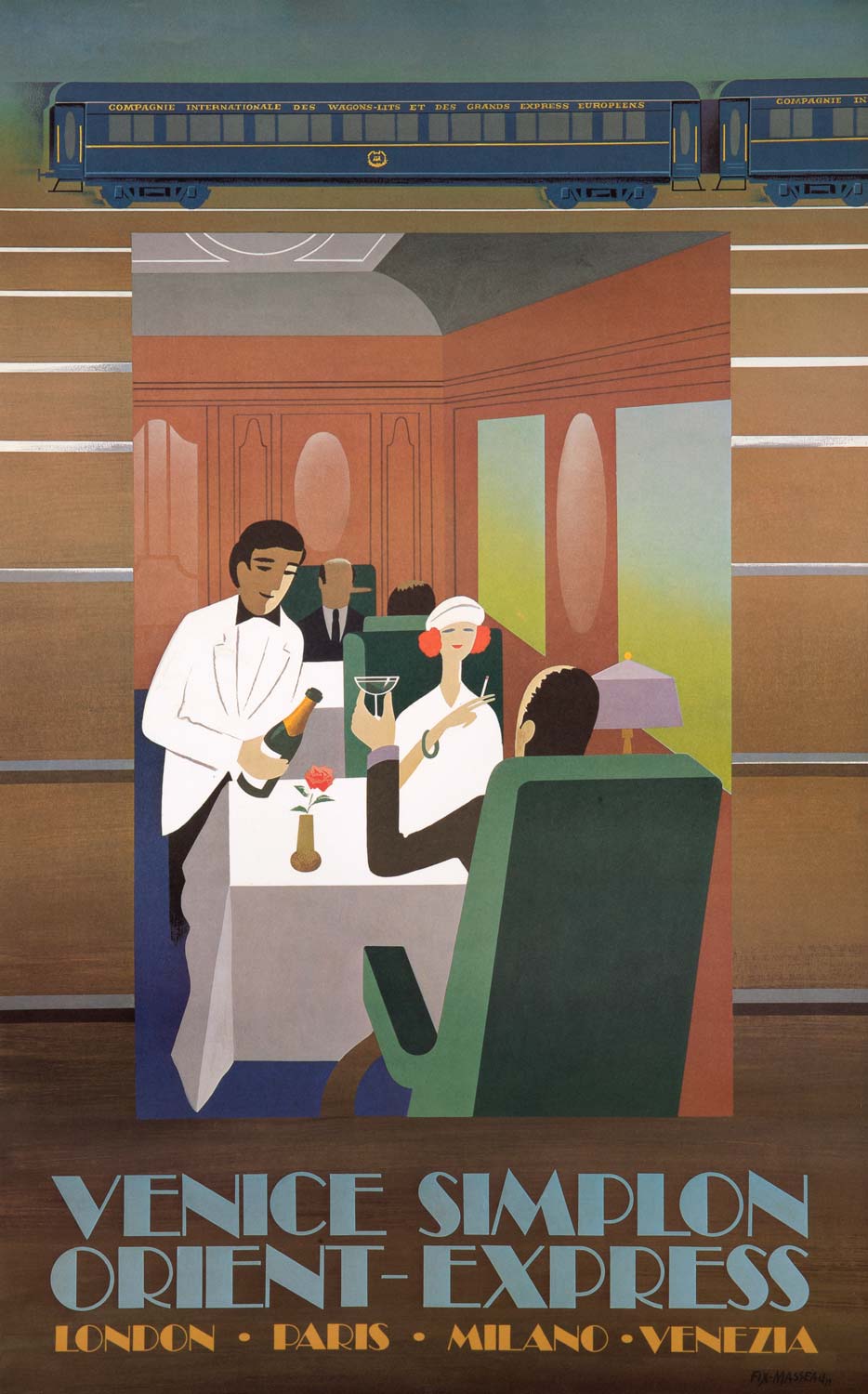
The retro posters became successful, because Art Deco witnessed a revival in the early 1980s. This was also visible in the work of young artists, including Razzia (Gérard Courbouleix–Dénériaz, 1950), who was influenced by Fix-Masseau. The renewed interest in the latter's work resulted in re-editions of his early posters as lithographic art prints, including 'Exactitude'. In 1983 a retrospective exhibition of Fix-Masseau's posters was held at the Bibliothèque Nationale in Paris.

